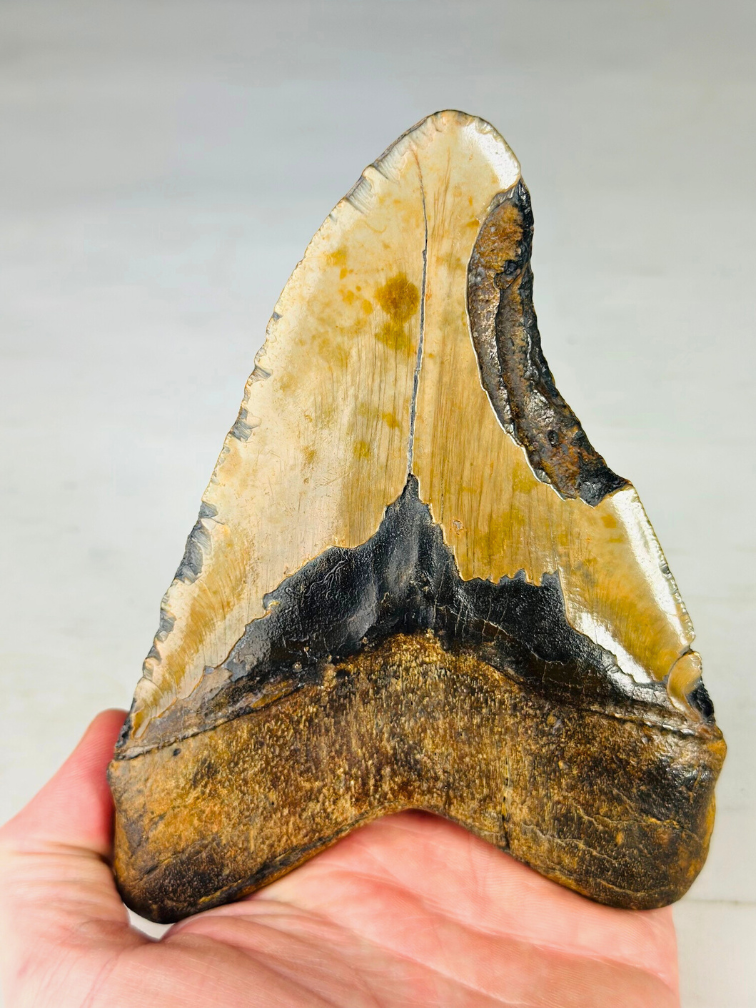Megalodon Tooth "Broken Lock" (US) - 14,7 cm
This 14,7 cm (5,79 inch) Megalodon tooth was found in the US, Florida - in 2020. This Megalodon tooth features a beautiful grey colour. This tooth still has beautiful sharp edges so a great collectible. This tooth (weighing 384 grams).
The fossil tooth comes from a Megalodon shark (Otodus Megalodon) that could eventually grow as long as 20 metres and weigh 60,000 kilos. The teeth of the Megalodon are virtually the only fossils found of this magnificent species, and those teeth speak volumes.
Important: this Megalodon tooth is 100% natural (nothing has been restored/improved).
Insured shipping: we pack and ship the tooth carefully and all our packages are insured by us. This means: no risk for you.
- Megalodon tooth size: 14,7 cm (5,79 inch);
- Scientific name: Otodus Megalodon;
- Age: NEOGEEN (2.58-23.03 million years);
- Condition: Natural; Nothing restored;
- Origin: North Carolina, USA;
- Weight: 384 grams;
- Where found: in the sea;
- Year found: 2020.
Meaning of 'Megalodon
Megalodon' has a short but very clear meaning: 'Big Teeth'. The oldest teeth ever found date back 20 million years. The largest Megalodon tooth ever found was no less than 19 centimetres in size. Because no complete fossilised bones have been found apart from the teeth, this species was given the name 'Megalodon', which also means: 'Big Teeth'.
The teeth of Megalodon are practically the only fossils found of this magnificent species, and those teeth speak volumes.
Why is a Megalodon tooth so special?
The Megalodon is an ancient and extinct species of shark that ruled our oceans millions of years ago. The Megalodon was an Apex predator and had few or no equals. Below, we would like to give some reasons why a Megalodon tooth is so special:
History and mystery: This titan lived between 23 million years and 3.6 million years ago and was the sole ruler of our oceans. Megalodon's magnificent teeth are the only fossils that have survived from this unique animal. This makes Megalodon teeth not only rare as the only surviving fossil but also impressive.
Size: Megalodon teeth are the largest compared to any other shark species. significantly larger than those of any other shark species. The average length of a Megalodon tooth is between 12 and 18 cm. They are also incredibly sharp with beautiful serrated edges, indicating their destructive bite.
Value of a Megalodon tooth: A Megalodon tooth is very popular among fossil collectors and scientists. This is because Megalodon teeth are rare, even though we are currently finding so many of them. The rarity is mainly due to the fact that a tooth is the only physically tangible thing from this shark species.
How can you be sure that your purchased Megalodon tooth is real?
Besides the fact that we at Megalodontand.nl only buy from divers and miners, we also issue a certificate with each tooth. This certificate (Certificate of Authentication) ensures that we can say with certainty that the tooth we sell is actually a real tooth. Of course, there are several ways to tell whether a tooth is real or fake. We would like to give you some tips on how to recognise a real tooth:
Size: Megalodon teeth vary between 4 cm and 19 cm. In addition, in some cases Megalodon teeth are restored, as a result the root may be slightly larger and the tooth may also feel lighter. This does not mean that the tooth is fake. The tooth is just 100% real, however, something has broken off during mining or surfacing. To still restore the tooth to its full glory, often the root and very occasionally the enamel are restored.
Colour: Megalodon tooth colours range from black, grey, red to really rare white. In addition, the tooth can even have a blue tint. The colour of the tooth is determined by the minerals in the soil in which it is found.
Origin: Our teeth come exclusively from the United States or Indonesia. These teeth are found in places where it has been scientifically proven that many Megalodon once swam here.
Expand your collection with a Megalodon tooth
Owning a Megalodon tooth offers an exceptional opportunity to get a piece of prehistory in your hands. The Megalodon tooth is a beautiful, rare and valuable fossil. In addition, these teeth are a unique addition to any collection and a wonderful opening for a conversation topic.
A perfect gift for lovers of prehistory
A Megalodon tooth is a perfect gift for any fossil collector and for anyone fascinated by the history of our earth. Make your friends and family intensely happy with a wonderful prehistoric gift.
Order your Megalodon tooth today
Order your favourite tooth today at Megalodontand.nl and add a valuable piece of prehistory to your collection. In addition, be amazed by this magnificent titan. You will be amazed by the strength and beauty of these unique fossils.











